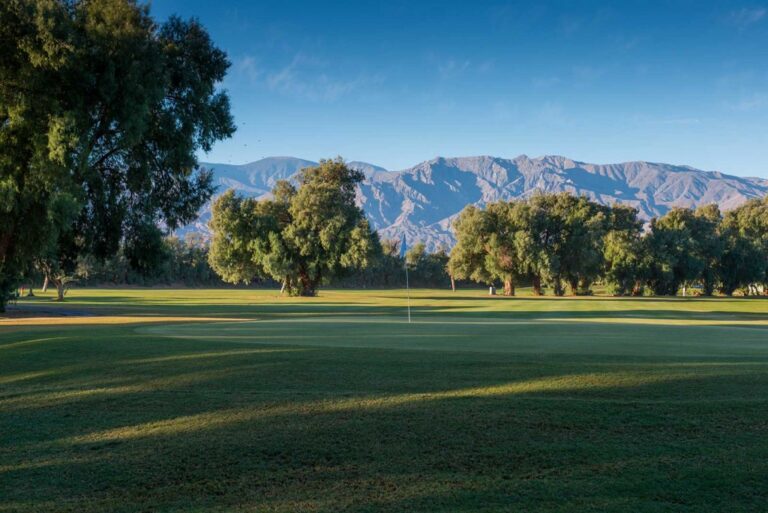DEATH VALLEY, Cal. (Aug. 12, 2017) – Would you be surprised if someone told you a golf course in Death Valley, site of the lowest point in the North America and one of the hottest places on the North American continent, has more water to keep its facility green than many American courses?
The healthy and green tees, fairways and putting surfaces at Furnace Creek Golf Course are just some of the myriad revelations folks get when they head down into the Great Basin, the area between the Armargosa Mountain Range on the east and the Panamint Range to the west.
“Hot and dry” might be the first few words that come to mind when someone thinks of Death Valley and especially its lone place to play golf.
But the 90-year-old Furnace Creek GC is a wonder of life. It’s an oasis in the desert, kept alive by a series of springs and aquifers. The venue, set at 214 feet below sea level, is the lowest grass course in the world, giving a new meaning to the golf term, “going low.”
Badwater Basin in Death Valley National Park is the lowest place in North America and one of the lowest places in the world at 282 feet below sea level. The Dead Sea, between Israel and Jordan, is the lowest at 1,371 feet below sea level.
During the summer – when temperatures routinely reach more than 125 degrees Fahrenheit – the exceedingly hot and dry conditions in Death Valley are what make Furnace Creek an extreme challenge.
The highest temperature ever recorded in the Western Hemisphere was at the Furnace Creek Resort on July 10, 1913, when the mercury almost boiled over at 134 degrees. It still ranks as the second-highest temperature ever recorded in the world, just behind the 136 in Libya on September 13, 1922.
The average daily temperature in July and August over the past century is around 115, but marks in the mid-120s are not uncommon in those months. And in the summertime, prowess with putter becomes harder because the grass on the greens is kept longer so the turf doesn’t fry and die.
In the other three seasons, the weather is mostly pleasant. But at those times it’s the slightly greater gravity and barometric pressure that affect golfers, because in such heavy air balls just don’t go as far or stay in the air as long. Down here drives and approach shots travel 10 to 20 yards less, so players need to take one extra club more than normal.
There’s a distinct difference in how the ball responds in relation to other courses at or above sea level. And because of those factors, Furnace Creek GC – a par-70 that plays just 6,236 yards from its back set of four tees – has been recognized by Golf Digest as one of “America’s 50 Toughest Courses.” Its unique environmental conditions have to be taken into consideration, as the course’s rating is just 70.3 and its Slope only 117.
Death Valley National Park, a region filled with arid mountains, huge fields of jagged rocks and giant sand dunes in the Mojave Desert near the California-Nevada border, features some of the hottest, driest and lowest spots on Earth. Here there are immense stretches of isolated, rock-strewn sand; frankly, it’s the last place in the world one would expect to find a golf course.
But a couple of the pretty good golf architects liked what they saw and made the most of it.
Furnace Creek GC, named after the plush resort alongside a few of its holes and the historic Inn a quarter-mile up the road, opened in 1927 as a three-hole layout designed by a local ranch hand on property owned by a date and palm farmer named Murray Miller. The track expanded to nine holes in 1931 and became the first grass golf course in the California desert.
In the early years, the course was closed and leased to a cattle rancher in the summer, and in winter the fairways were “mowed” by a flock of sheep.
In 1968, renowned golf course architect William F. Bell designed a second nine holes and the entire facility was renovated by Perry Dye, son of Hall of Fame designer Pete Dye, in 1997.
Dye’s changes included completely rebuilding five holes, adding fairway bunkers and mounds to better define holes, and rebuilding greens and tees. At the same time, a modern irrigation system was installed.
The course, a certified Audubon Cooperative Sanctuary (meaning it provides and maintains wildlife habitat, recycles water and manages the landscape responsibly), attracts all kinds of birds and animals and sprouts plenty of flora on the edges of the rough bordering fairways.
Some of these fairways parallel each another, giving the course an even wider look at a few junctures. Both Bell and Dye used towering date palms and decades-old tamarisks to delineate the driving corridors.
The last line of defense, as always, is Furnace Creek GC’s putting surfaces. The greens here are quite small and very difficult to read; it’s hard to discern the fall line when you’re playing golf at the lowest place on the continent. There are few bunkers and water enters play on nine holes.
Furnace Creek has a 34-36 routing, with the front side offering trio of par-3s and a single par-5, while the back has only one par-3 and one par-5. Seven of the track’s par-4s play less than 351 yards (but remember the low altitude).
The toughest stretch is likely hole Nos. 5-7, which starts with a 573-yard par-5, continues with a 440-yard two-shotter, and ends with a 351-yard par-4 that asks for a pinpoint drive between a pair of tall trees at the head of the landing area. Furnace Creek’s best hole is the 304-yard par-4 15th, a dogleg-left that requires a dead-on drive to have any chance at attacking the elevated green.
Because of its relative seclusion, Furnace Creek is typically played by guests at The Oasis at Death Valley (which was formerly called the Inn at Furnace Creek and the Ranch at Furnace Creek). The result is that scheduling tee times is easy as long as a tournament is not on the books.
Since June 2011, Furnace Creek has been the home of the Heatstroke Open, a two-day event played at or near the height of summer. It’s golf at its most extreme, and – like just about everything else in Death Valley – more about survival than superlatives.
Keep two things in mind when playing here: first, continually hydrate while in the sun, as even in the cooler months, the lack of humidity will sap you faster than you realize; secondly, this is a course you cannot afford to like lightly in any way.
The resort is operated by Xanterra Parks and Resorts, a company that has received scads of awards for its environmental stewardship, from one of the largest solar installations in the country to sustainable cuisine. Xanterra is the first U.S. hospitality company to commit to an absolute reduction target in greenhouse gas emissions (through a partnership with the World Wildlife Fund), and the only hospitality company to actually achieve that goal.
When done playing 18 holes, hike the many jagged rock formations and sand dunes along the California-Nevada border, including Devil’s Golf Course, a beautiful but stark landscape formed by an evaporated salt lake. It’s not a real golf course, and its salt ridge can be razor-sharp.
Visitors can also venture to Scotty’s Castle, a boondoggle that is a window into the life and times of the Roaring 20s and the Great Depression. It was and is an engineer’s dream estate, a wealthy matron’s vacation home and a man-of-mystery’s hideout and getaway.
Then there’s The Racetrack, a dry lakebed best known for its strangely “moving” rocks. Although no one has actually seen the rocks move, the long meandering tracks left behind in the mud surface of the playa attest to their activity.
Another place to see is the Mesquite Flat Sand Dunes, which rise nearly 100 feet above the desert floor. Late-afternoon light accentuates the ripples and patterns, while morning is a good time to view the tracks of nocturnal wildlife. Moonlight on these dunes can be magical, yet night explorers should be alert for sidewinder rattlesnakes in the warm season. It was here that the Tatooine scenes in the “Star Wars” series were filmed.


